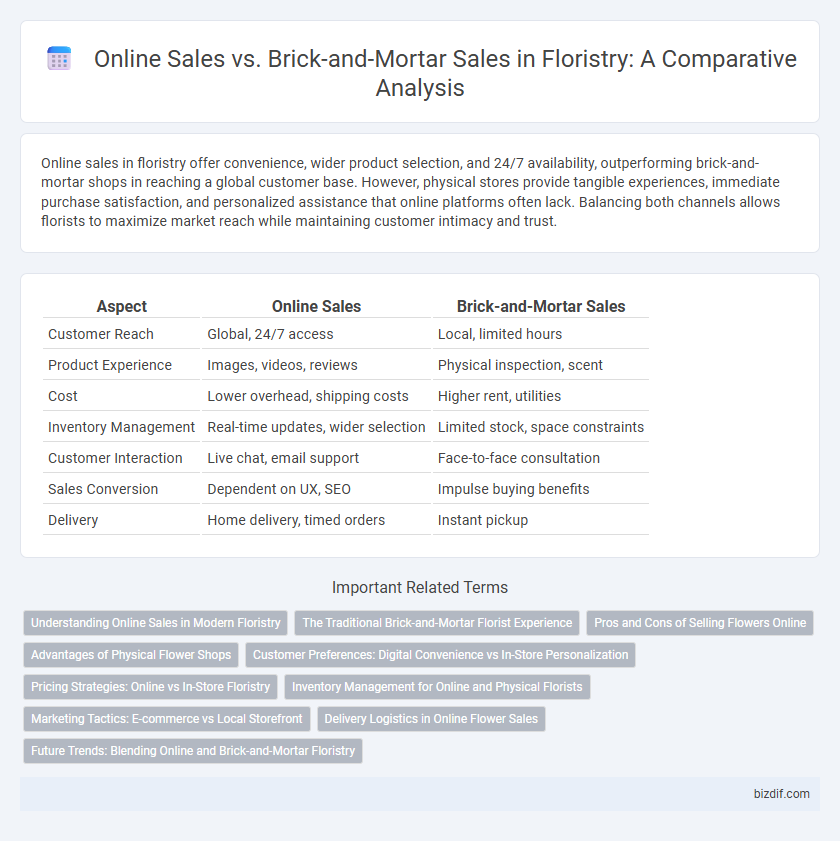Online sales in floristry offer convenience, wider product selection, and 24/7 availability, outperforming brick-and-mortar shops in reaching a global customer base. However, physical stores provide tangible experiences, immediate purchase satisfaction, and personalized assistance that online platforms often lack. Balancing both channels allows florists to maximize market reach while maintaining customer intimacy and trust.
Table of Comparison
| Aspect | Online Sales | Brick-and-Mortar Sales |
|---|---|---|
| Customer Reach | Global, 24/7 access | Local, limited hours |
| Product Experience | Images, videos, reviews | Physical inspection, scent |
| Cost | Lower overhead, shipping costs | Higher rent, utilities |
| Inventory Management | Real-time updates, wider selection | Limited stock, space constraints |
| Customer Interaction | Live chat, email support | Face-to-face consultation |
| Sales Conversion | Dependent on UX, SEO | Impulse buying benefits |
| Delivery | Home delivery, timed orders | Instant pickup |
Understanding Online Sales in Modern Floristry
Online sales in modern floristry leverage e-commerce platforms to reach a wider customer base beyond local geographic constraints, offering convenience through 24/7 access and personalized floral arrangements using AI-driven recommendations. Data analytics enable florists to track consumer preferences and optimize inventory, while digital marketing strategies help increase visibility and drive targeted traffic to online stores. Compared to brick-and-mortar sales, online floristry sales face challenges such as ensuring timely delivery and managing perishable products but capitalize on scalability and diverse payment options.
The Traditional Brick-and-Mortar Florist Experience
The traditional brick-and-mortar florist offers a sensory experience unmatched by online sales, allowing customers to see, touch, and smell fresh flowers before purchasing. Personalized customer service and expert advice contribute significantly to building trust and loyalty in local communities. While online platforms provide convenience, the tangible ambiance and immediate availability of floral arrangements remain key advantages of physical flower shops.
Pros and Cons of Selling Flowers Online
Selling flowers online offers a broader customer reach and lower overhead costs compared to traditional brick-and-mortar shops, boosting potential profitability. However, challenges include ensuring the freshness of blooms during shipping and reduced personal customer interactions, which can impact brand loyalty. Despite logistical complexities, online sales enable florists to leverage digital marketing and convenient ordering, expanding market presence beyond physical locations.
Advantages of Physical Flower Shops
Physical flower shops offer tactile experiences that online platforms cannot replicate, allowing customers to see and smell fresh blooms before purchase, ensuring satisfaction with quality and freshness. Personalized customer service in brick-and-mortar floristry fosters trust and expert advice, leading to tailored floral arrangements for special occasions. Local flower shops enable immediate availability and same-day delivery, meeting urgent needs that online sales may struggle to fulfill efficiently.
Customer Preferences: Digital Convenience vs In-Store Personalization
Customers increasingly prioritize the digital convenience of online floristry sales, valuing 24/7 access, easy comparison, and doorstep delivery. Brick-and-mortar shops remain preferred for in-store personalization, offering tactile experiences and expert floral arrangement advice. The growing trend suggests florists must integrate seamless online platforms with personalized in-store services to meet diverse customer preferences effectively.
Pricing Strategies: Online vs In-Store Floristry
Online floristry sales often leverage dynamic pricing models driven by market demand, allowing flexible discounts and personalized offers that attract price-sensitive customers. In-store pricing strategies typically emphasize fixed prices with premium charges for immediate availability, personalized customer service, and product freshness assurance. Comparing both, online platforms benefit from cost savings on overhead, enabling competitive pricing, while brick-and-mortar shops rely on experiential value to justify higher prices.
Inventory Management for Online and Physical Florists
Effective inventory management in floristry requires real-time tracking and demand forecasting tailored to online and brick-and-mortar sales channels. Online florists benefit from centralized inventory systems integrating supplier data to accommodate rapid order fulfillment and minimize perishable waste. Physical stores rely on localized stock monitoring to optimize flower freshness, manage in-store displays, and adjust orders based on walk-in customer trends.
Marketing Tactics: E-commerce vs Local Storefront
E-commerce floristry leverages targeted social media advertising and search engine optimization to attract a broad, diverse customer base while offering convenience through personalized online ordering and delivery options. Local storefronts emphasize community engagement by hosting in-person events, providing immediate product availability, and fostering customer relationships through personalized service and loyalty programs. Both marketing tactics prioritize showcasing seasonal floral arrangements and customizing promotions based on consumer behavior data to maximize sales and brand loyalty.
Delivery Logistics in Online Flower Sales
Efficient delivery logistics are crucial for online flower sales, as timely and fresh delivery directly impacts customer satisfaction and repeat purchases. Online florists invest in refrigerated transport and route optimization technologies to maintain flower freshness and reduce delivery times. Compared to brick-and-mortar stores, online sales rely heavily on reliable courier networks and real-time tracking systems to manage perishable inventory and meet exact delivery windows.
Future Trends: Blending Online and Brick-and-Mortar Floristry
Future trends in floristry highlight the integration of online sales platforms with brick-and-mortar stores to create seamless customer experiences. Hybrid models utilize augmented reality for virtual bouquet customization while maintaining in-store consultations and same-day deliveries, enhancing convenience and personalization. Data-driven inventory management synchronizes online demand with physical stock, optimizing supply chains and reducing waste.
Online sales vs Brick-and-mortar sales Infographic

 bizdif.com
bizdif.com